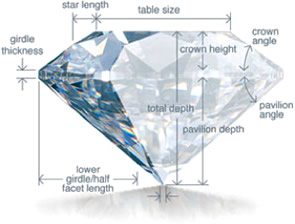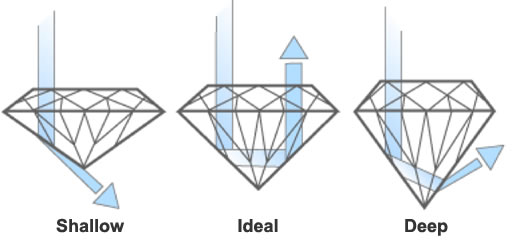DIAMOND EDUCATION ~ THE 4 C'S

Cut is the factor that fuels a diamond's fire, sparkle and brilliance. When a diamond has been correctly cut, its ability to reflect and refract light is greatly enhanced. A diamond's cut grade is actually a combination of three different types of reflection: brilliance (the total light reflected from a diamond), fire (the dispersion of light into the colors of the spectrum), and scintillation (the flashes of light, or sparkle, when a diamond is moved).
The quality of cut is determined by how well the symmetry, polish, and proportions of the diamond produce the most attractive balance of the three different types of reflection. A round brilliant cut diamond has 57 or 58 facets, the 58th being a tiny flat facet at the bottom of the pavilion that's known as the culet. The large, flat facet on the top is the table. The proportions of a diamond refer to the relationships between table size, crown angle and pavilion depth.When a diamond is cut to good proportions, light enters the stone and is reflected from one facet to another and then dispersed out through the top of the stone. If the cut of the diamond is too deep, some light escapes through the opposite side of the pavilion. If the cut is too shallow, light escapes through the pavilion
before it can be reflected, thus reducing brilliancy.
In early 2005, GIA unveiled a diamond cut grading system for standard round brilliants in the D-to-Z color range. This system, the product of more than 15 years of intensive research and testing, assigns an overall diamond cut grade ranging from Excellent to Poor.

© 2025 Julia Failey / Site Map / Security and Privacy
